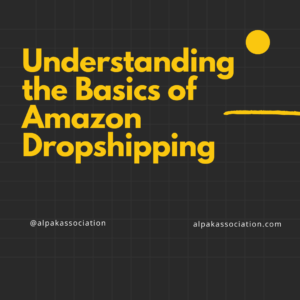Amazon Dropshipping Basics: A Complete Guide
Introduction to Amazon Dropshipping
In the realm of e-commerce, dropshipping has emerged as a popular business model, offering entrepreneurs a low-risk entry into the market. Among the various platforms available, Amazon stands out as a leading choice for dropshipping due to its vast reach, robust infrastructure, and established customer base. In this comprehensive guide, we’ll delve into the basics of Amazon dropshipping, from understanding the concept to implementing strategies for success.
What is Dropshipping?
Before delving into Amazon dropshipping specifically, let’s first clarify what dropshipping entails. At its core, dropshipping is a retail fulfillment method where the seller doesn’t keep the products in stock. Instead, when a product is sold, the seller purchases it from a third party and has it shipped directly to the customer. This eliminates the need for inventory storage and upfront investment in stock, making it an attractive option for aspiring entrepreneurs.
Why Choose Amazon for Dropshipping?
Amazon’s dominance in the e-commerce landscape makes it an enticing platform for dropshipping ventures. With millions of active users and a reputation for reliability, Amazon provides unparalleled exposure to a global audience. Moreover, its Fulfillment by Amazon (FBA) service streamlines the shipping and handling process, offering convenience and efficiency to sellers.
Understanding the Basics of Amazon Dropshipping

1. Product Research
Before diving into Amazon dropshipping, it’s essential to conduct thorough product research. Identify trending items with high demand and low competition to maximize profitability. Utilize tools like Jungle Scout or Helium 10 to analyze market trends and assess the competition effectively.
2. Setting Up an Amazon Seller Account
To start dropshipping on Amazon, you’ll need to create a seller account. Choose between an Individual or Professional plan based on your anticipated sales volume. Complete the registration process and provide the necessary documentation to verify your identity.
3. Sourcing Suppliers
In dropshipping, selecting reliable suppliers is paramount to ensuring a smooth operation. Look for suppliers with a proven track record of timely shipping and quality products. Alibaba, AliExpress, and SaleHoo are popular platforms for finding reputable suppliers.
4. Listing Products on Amazon
Once you’ve sourced your products, it’s time to list them on Amazon. Optimize your product listings with high-quality images, compelling descriptions, and relevant keywords to improve visibility and attract potential buyers.
5. Managing Orders and Customer Service
As orders start rolling in, stay on top of order management and customer inquiries. Utilize Amazon’s seller dashboard to monitor orders, track shipments, and address customer concerns promptly. Providing excellent customer service is crucial for building trust and fostering repeat business.
Strategies for Success in Amazon Dropshipping

1. Niche Selection
Focus on a specific niche or product category to differentiate yourself from competitors and target a more defined audience. Niching down allows you to establish yourself as an authority in your chosen market segment, increasing the likelihood of success.
2. Price Competitiveness
Stay competitive by regularly monitoring prices and adjusting your pricing strategy accordingly. While maintaining profitability is essential, offering competitive prices can help you stand out in a crowded marketplace and attract price-conscious shoppers.
3. Streamlined Operations
Efficient order processing and fulfillment are key to running a successful dropshipping business. Implement automated tools and processes to streamline operations, minimize errors, and enhance overall efficiency.
4. Customer Satisfaction
Prioritize customer satisfaction by providing timely shipping, responsive customer support, and hassle-free returns. Positive reviews and word-of-mouth referrals can significantly impact your reputation and drive future sales.
Conclusion
In summary, Amazon dropshipping offers a lucrative opportunity for entrepreneurs to enter the e-commerce landscape with minimal risk and overhead. By understanding the fundamentals of dropshipping, leveraging Amazon’s platform, and implementing effective strategies, aspiring dropshippers can build a profitable business and achieve long-term success.
FAQs (Frequently Asked Questions)
1. Is dropshipping allowed on Amazon?
Yes, dropshipping is allowed on Amazon, but sellers must adhere to certain guidelines and policies outlined by theamazon platform.
2. Do I need a business license to start dropshipping on Amazon?
While not strictly required, having a business license can provide legitimacy to your venture and may be necessary for tax purposes. It’s advisable to consult with a legal professional to understand the requirements in your jurisdiction.
3. How much can I expect to earn from Amazon dropshipping?
Earnings potential in Amazon dropshipping varies depending on various factors such as product selection, pricing strategy, and market demand. With diligent research and strategic execution, it’s possible to generate significant profits over time.
4. What are the main challenges of Amazon dropshipping?
Common challenges in Amazon dropshipping include managing inventory, dealing with supplier issues, and navigating competition. However, with careful planning and proactive management, these challenges can be overcome.
5. Can I dropship from any country to sell on Amazon?
While dropshipping from any country is technically possible, sellers should consider factors such as shipping times, customs regulations, and product quality when selecting suppliers. It’s essential to choose reliable suppliers that can meet Amazon’s fulfillment standards.
